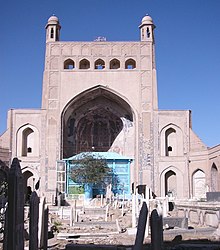This is an old revision of this page, as edited by MezzoMezzo (talk | contribs) at 04:03, 17 November 2013 (while this might be true, ibn al qayyim's own book can't be a source for his own opinions; find a reliable secondary source per WP:IRS). The present address (URL) is a permanent link to this revision, which may differ significantly from the current revision.
Revision as of 04:03, 17 November 2013 by MezzoMezzo (talk | contribs) (while this might be true, ibn al qayyim's own book can't be a source for his own opinions; find a reliable secondary source per WP:IRS)(diff) ← Previous revision | Latest revision (diff) | Newer revision → (diff)| This article needs additional citations for verification. Please help improve this article by adding citations to reliable sources. Unsourced material may be challenged and removed. Find sources: "Abdullah Ansari" – news · newspapers · books · scholar · JSTOR (April 2012) (Learn how and when to remove this message) |
Abu Ismaïl Abdullah al-Herawi al-Ansari or Khajah Abdullah Ansari of Herat (1006–1088) (Template:Lang-fa) also known as Pir-i Herat (Template:Lang-fa) (sage of Herat) was a famous Persian Sufi who lived in the 11th century in Herat (then Khorasan, now Herat province, Afghanistan). One of the outstanding figures in Khorasan in the 5th/11th century: commentator of the Koran, traditionist, polemicist, and spiritual master, known for his oratory and poetic talents in Arabic and Persian.

Life
He was born in the Kohandez, the old citadel of Herat, on 4 May 1006. His father Abu Mansur, was a shopkeeper who had spent several years of his youth at Balkh. Abdullah was the disciple of Shaikh Abul Hassan Kharaqani, for whom he had deep respect and faith, as he has said: "Abdullah was a hidden treasure, and its key was in the hands of Abul Hassan Kharaqani."
He practiced the Hanbali fiqh, one of the four Sunni schools of law or jurisprudence. His shrine, built during the Timurid Dynasty, is a popular pilgrimage site.
He wrote several books on Islamic mysticism and philosophy in Persian and Arabic. His most famous work is "Munajat Namah" (literally 'Litanies or dialogues with God'), which is considered a masterpiece of Persian literature. After his death, many of his sayings that had been transmitted by his students along with others that were in his written works were included in the Tafsir of Maybudi, "Kashf al-Asrar" (The Unveiling of Secrets). This is among the earliest complete Sufi Tafsirs of Quran and has been published several times in 10 volumes.
He excelled in the knowledge of Hadith, history, and Ilm ul-Ansaab. He used to avoid the company of the rich, powerful and the influential. His yearly majlis-e-wa'az was attended by people from far and wide. Whatever his disciples and followers used to present to him was handed over to the poor and the needy. He is said to have had a very impressive personality, and used to dress gracefully.
Khwajah Abdullah Ansari of Herat was a direct descendant of Abu Ayyub al-Ansari, and was the ninth in line from him. The lineage is described, and traced in the family history records, as follows;
Abu Ismail Khajeh Abdollah Ansari, son of Abu Mansoor Balkhi, son of Jaafar, son of Abu Mu'aaz, son of Muhammad, son of Ahmad, son of Jaafar, son of Abu Mansoor al-Taabi'i, son of Abu Ayyub al-Ansari.
In the reign of the third Caliph amongst the Khulafaa-e-Rashideen of Islam, Uthman ibn Affan, Abu Mansoor al-Taabi'i took part in the conquest of Khorasan, and subsequently settled in Herat, his descendant Khwajah Abdullah Ansari died there in 1088.
Books (in Persian)
- Kashf al-Asrar wa 'Iddat al-Abrar (Quran exegesis) (dari : کشف الاسرار و عدة الابرار)
- Munajat Namah (dari : مناجات نامه)
- Nasayeh (dari : نصایح)
- Zad-ul Arefeen (dari : زاد االعالرفین)
- Kanz-ul Salikeen (dari : کنز السالکین)
- Haft Hesar (dari : هفت حصار)
- Elahi Namah (dari : الهی نامه)
- Muhabbat Namah (dari : محبت نامه)
- Qalandar Namah (dari : قلندر نامه)
- Resala-é Del o Jan (dari : رساله دل و جان)
- Resala-é Waredat (dari : رساله واردات)
- Sad Maidan (dari : صد میدان)
- Resala Manaqib Imam Ahmad bin Hanbal
Books (in Arabic)
- Anwar al-Tahqeeq
- Zem al-Kalam
- Manāzel al-Sā'erīn
- Kitaab al-Frooq
- Kitaab al-Arba'een
See also
- Abul Hassan Kharaqani
- Firangi Mahal
- Abu Ayyub al-Ansari
- Ibn al-Qaisarani
- Khwaja 'Abd Allah Ansari shrine
- Khwaja
- Sufism
Further reading
- Biography of Al-Ansari by Shaykh G.F. Haddad
- Stations of the Sufi Path, The One Hundred Fields (Sad Maydan) of Abdullah Ansari of Herat, translated by Nahid Angha www.archetypebooks.com
References
- Arthur John Arberry, "Sufism: an account of the mystics of Islam", Courier Dover Publications, 2001. pg 69: "This manual was well regarded in later times; commentaries upon it were written among others by the celebrated Persian mystic Ansari"
- A. G. Ravân Farhâdi, ʻAbd Allāh ibn Muḥammad Anṣārī al-Harawī, "ʻAbdullāh Anṣārī of Herāt (1006-1089 C.E.): an early Ṣūfi master",Routledge, 996.
- ^ S. de Laugier de Beaureceuil, "Abdullah Ansari" in Encylcoapedia Iranica
- The Ulama of Farangi Mahall and Islamic Culture in South Asia, Francis Robinson, Ferozsons (pvt) Limited, Pakistan. 2002
| Part of a series on Islam Sufism |
|---|
 |
| Ideas |
| Practices |
Sufi orders
|
| List of sufis |
| Topics in Sufism |
|
|